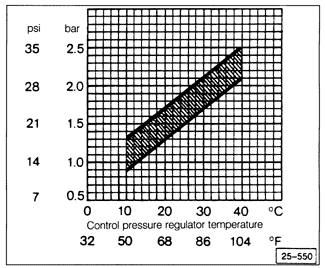Control PressureControl pressure is that which is determined by the control pressure regulator. It helps regulate the response of the control plunger and, therefore, influences the fuel mixture. Measurement of control pressure is the primary way of evaluating the control pressure regulator. Control pressure is not adjustable, and if the pressure is not within specifications the control pressure regulator should be replaced. System pressure influences control pressure, and should be checked, as described above, prior to checking control pressure. Check control pressure with the pressure gauge connected as described above at the beginning of 5.5 Fuel Pressure Tests and Specifications, and the gauge valve open. A major function of the control pressure regulator is to adapt the fuel mixture for cold starting and cold running, so control pressure should first be checked with the engine completely cold. To check cold control pressure, disconnect the harness connectors from control pressure regulator and the auxiliary air regulator, then start the engine. Cold control pressure varies with temperature. On U.S. cars, the measured control pressure should correspond to the chart in Fig. 5-22. On Canada cars with engine code MZ, the cold control pressure should be approximately 0.3 bar (4.4 psi) below the value shown in Fig. 5-22. For example, at 68°F (20°C) a Canada car with MZ engine should have a cold control pressure of 1.2±0.15 bar (17.4±2 psi). If cold control pressure is too high, check for a blocked or kinked fuel line. Also, remove the fuel union at the control pressure regulator and check for a plugged filter screen. If no such faults are found, the control pressure regulator is faulty and should be replaced.
To check warm control pressure, reconnect the harness connectors to the control pressure regulator and the auxiliary air regulator. Run the engine until the control pressure is no longer increasing (about 2 minutes). The warm control pressure should be between 3.4 and 3.8 bar (49 and 55 psi). U.S. cars with engine code GX, except those sold new in California, have control pressure regulators which compensate for changes in altitude. Fig. 5-23 is a graph of warm control pressure vs. altitude above sea level.


If the warm control pressure is too high, check for a blocked or kinked fuel line. Also, remove the fuel union at the control pressure regulator and check for a plugged filter screen. If no such faults are found, the control pressure regulator is faulty and should be replaced. If warm control pressure is too low, or takes more than about 2 minutes to reach its peak, test the resistance of the heating element and test for voltage reaching the harness connector, as described in 5.3 Cold Running Enrichment. |